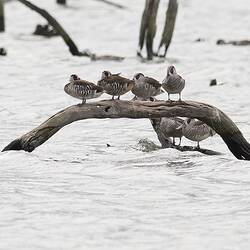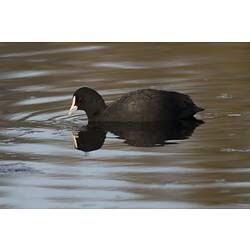General Description
Small duck, Wings and back brown. Neck, breast, sides and underparts heavily barred (white and dark brown stripes). Head grey, face white with large brown patch around eyes and small pink spot of feathers behind (giving their common name). Bill to tail length up to 45 cm.
Biology
Pink-eared Ducks feed by sucking water in through their bill tip then filtering it out the sides. Comb-like structures (lamellae) along the sides of the bill trap food particles, including tiny invertebrates and microscopic plants. Pairs of ducks feed in shallow waters by vortexing: two ducks swim head-to-tail in a circle, concentrating invertebrates together in a spinning water column. Pink-eared Ducks are highly nomadic in response to rainfall and can form huge flocks that fly great distances to find water. Breeding is dependent on rainfall, occurring throughout the year whenever water conditions are favourable. They use nests constructed by other waterbirds, especially the Black-tailed Native Hen, Gallinula ventralis, and Eurasian Coot, Fulica atra, or build a mound of down in a hollow tree, branch, stump or log typically above water. Both parents care for the chicks. Pink-eared Ducks are rarely seen away from water.
Distribution
Mainland Australia and occasionally Tasmania.
Habitat
Shallow temporary waters including lakes, swamps and wetlands.
More Information
-
Animal Type
-
Animal SubType
-
Brief Id
Duck with zebra-like stripes on the underparts, large spatula-like bill, brown eye patch and a small pink patch behind the eyes.
-
Colours
Brown, White, Pink
-
Habitats
-
Diet
Omnivore
-
Diet Categories
Invertebrates, Plant matter
-
Endemicity
-
Commercial
No
-
Taxon Name
-
Common Name
Pink-eared Duck
-
Kingdom
-
Phylum
-
Subphylum
-
Class
-
Subclass
-
Order
-
Family
-
Subfamily
-
Genus
-
Species Name
membranaceus




